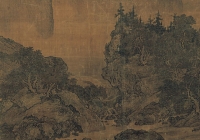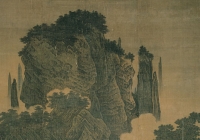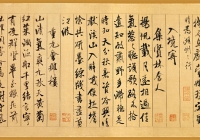TELDAP Collections
| Grand View – Painting and Calligraphy of the Northern Sung (960-1127) |
|
The main aspects of Chinese painting, such as the techniques of rendering, specialization of painters, ideas of painting, types of painting subjects, the establishment of individual styles and regional manners, and the cultural realm of painting all matured in the Northern Sung period and reached a level of completion. Later generations often followed the modes and ideas established in this period to develop their own paths in painting..
In Sung dynasty records on painting, the painter of "Travelers Among Mountains and Streams", Fan K'uan, is described as a specialist "famous in his day". From the viewpoint of regional style, some scholars consider this painting as an ideal representative of northern landscape painting in China. Others, from its format of arrangement, believe this masterpiece embodies a shift in compositional viewpoint that took place in Chinese painting at the time. In other words, the layered "high distance" composition derived from the T'ang dynasty has been developed into a perfected realm, this piece being considered as a representative of "monumental landscape" painting of the Northern Sung. Still other scholars, from a more philosophical viewpoint of the "Tao" (Way), believe that this work expresses the ideal of a harmonious relationship between humans and nature.
More than seventy years later, the court painter Kuo Hsi in Emperor Shen-tsung's reign (1068-1085) continued in the monumental landscape manner of "Travelers Among Mountains and Streams". In "Early Spring", he used the compositional formats of "high distance", "deep distance", and "level distance" to construct a full-scene "true landscape". Appearing in the painting are mountains and streams, woods, and buildings that appear to be of solid substance as well as elements of less concrete forms, such as clouds and mists, haze, and atmosphere, revealing the extraordinary painting skills of the artist in terms of his manipulation of solid and void. The logical relationship between the mountains, rocks, trees, and water has also been explained by some scholars as symbolic of a harmonious and orderly relationship in nature and among people in an ideal empire.
In both "Travelers Among Mountains and Streams" and "Early Spring", though ordinary figures are shown as miniscule in relation to the mountains, the artists painstakingly rendered their status, clothing, actions, and expressions. This notion of realism and narrative derives from the travel landscapes of the T'ang and Five Dynasties period. In the middle Northern Sung, during the latter half of the 11th century, this reached a perfection of expression. The 12th century also marks the last major imperial period of the Northern Sung under Emperor Hui-tsung (r. 1101-1125). In his reign, painting was fused with poetry, and abstract images from literary sources and symbolic techniques were injected into painting. "Windy Pines Among a Myriad Valleys", done in 1124 by Li T'ang, differs from the presentation of the previous two works. It includes no narrative figures or buildings to distract from the focus of the scenery. Rather, it uses the deep mountains, clouds, pines, waterfall, and rapids to suggest the theme of listening to wind rustling through pines deep in a valley, which was often mentioned in poetry of the period.
A succession of famous bird-and-flower painters appeared starting in the Five Dynasties period. Huang Ch'üan of Szechwan inherited from styles of the T'ang dynasty and selected from the virtues among them. His son Huang Chü-ts'ai served under the Sung and searched on behalf of the emperor for famous paintings, which is why the Huang manner came to predominate in the early Northern Sung. "Blue Magpie and Thorny Shrubs" cleverly incorporates the poses of birds into a scene from nature to create an appropriate sense of movement. The patterned decorative effect of the painting preserves the tradition of archaic simplicity and splendor of bird-and-flower painting from the T'ang dynasty. The more archaic techniques employed here include rubbing with a slanted brush laden with scorched ink for modeling the rock surfaces, ochre with ink yielding the solidity of thorny branches, and the technique of cinnabar washes for rendering the pointed fern-leaf hedge bamboo and beak and claws of the magpie. Although the sparrows on the thorny branches appear in various forms of complexity, they have not been abbreviated, which was one of the painting notions in the pursuit of realism in this early period.
In the reign of Emperor Shen-tsung, the style of Ts'ui Po was fashionable. Ts'ui not only captured the objects with a sense of liveliness, he also fastidiously produced compositions of clever animation. In his "Magpies and Hare" appear two magpies trying to scare off a hare, which looks back at them for a steady triangular relationship in contrast to the tension of the scene. The leaves and branches, bamboo, and grasses bend in the breeze to add a sense of movement to the otherwise static scenery. The magpies were rendered in forms with fine outlines of ink filled with colors, and the fur of the hare was done with fine lines, concealing the outlines and achieving a realistic effect. The leaves, bamboo, and grasses are also done with outlines filled with colors, but the thorny branches are in the "boneless" manner of wash painting, while rough touches of the brush on the tree trunk and the slanted brushwork for the slope both imbue the entire work with a heightened sense of animation.
Figure painting also made notable advances in the Northern Sung. In addition to following in the fine traditions of the T'ang dynasty, a uniquely elegant form of composition and brushwork developed at the time. "Eight Princes on a Spring Excursion" shows eight noblemen on a horseback outing, the figures and horses all with different expressions and in a variety of poses. Attention appears to be centered on the figure in green in the middle, group interaction surrounding him being captured perfectly. To highlight the figures, the background of the painting has also been simplified and the space defined by the railing to create a contrast between solid and void. The fine rendering of the tree and rock along with the opulence of the figures" clothing reveal an opulent style unique to the imperial clan of the time. Although the composition of "Eight Princes on a Spring Excursion" derives from the format of a horse and figure underneath a tree from the T'ang dynasty, the level of refinement here far surpasses that found in the T'ang or Five Dynasties period.
"Literary Gathering" is related to the theme of illustrating the Eighteen Scholars in the T'ang dynasty. Ever since Yen Li-pen was ordered to paint "Illustrations of the Eighteen Scholars of the House of Ch'in", it has become a subject for emulation by later generations of artists, who have done many versions through the ages. This work has poetic lines inscribed by Emperor Hui-tsung and his minister Ts'ai Ching on it, using an allusion to the past to point out an emphasis on the scholar class by the Sung imperial house while serving as a visual symbol of the emperor ruling over gathered talents at his command. The entire work has been done with well-executed brushwork, and the lines are succinct yet strong. The faces of the figures are outlined carefully and harmoniously, their expressions being elegant and positions of the figures differentiated for an obvious sense of individuality. The leaves of the bamboo and trees were done in outlines using steady strokes and orchestrated with beautiful coloring. The background of trees, rocks, and grasses in fine and regulated brushwork reveals the exceptional skills of the artist and fully expresses the pure and elegant style pursued in Emperor Hui-tsung's Painting Academy.
Su Shih's "The Cold Food Observance" (ca. 1084-1086), Huang T'ing-chien's "Poem on the Hall of Pines and Wind" (ca. 1102), and Mi Fu's "On Szechwan Silk" (1088) are important works of poetry composed and calligraphed by these three great masters of Northern Sung calligraphy. These three handscrolls all employ the most appropriate means of expression and personalized running script for the calligraphy, the contents of the poetry being related to the vicissitudes in the lives of these calligraphers. The expressions of the calligraphers shown here also reflect the emotions and thoughts at the time when the calligraphy was done.
"Poem on the Hall of Pines and Wind" presents somewhat similar circumstances, a touch of sadness within a mood of joy. Taking the opportunity to narrate a passage from a trip to the Wu-ch’ang Western Hills, Huang T'ing-chien fondly remembered a friend who had also traveled to this location, expressing a strong desire that his friend could share the beautiful scenery with him. Finally, Huang hoped to be able to free himself from the entanglement of his current situation and go with friends together on a boating trip. As he did the calligraphy, Huang’s wave-like features and large diagonally falling strokes, the pressing and lifting of the brush, and turns in the brushwork are found everywhere within the manner of regular script. The transformations are extremely well-handled, and the light stops and gradual lifting of the brush have a grace and bearing in a harmonious manner that shows Huang T’ing-chien’s aloofness from worldly concerns in later years and a self satisfaction at heart.
"On Szechwan Silk" is a handscroll that includes eight poems on six subjects in a variety of formats, including five- and seven-character archaic, truncated, and regulated verse. The entire scroll is composed of 556 characters in a total of 71 lines, being a masterpiece by Mi Fu at the age of 37. On one hand, the contents of the poetry reveal Mi Fu’s ambitions as an official and his praise of the literary talents of the recipient of the scroll. On the other hand, Mi Fu, using a precious piece of Szechwan silk, performed calligraphy to the best of his abilities, moving the brush both quick and slow, sometimes light and fleeting while at other times steady and heavier. The concealment and expressiveness of the brushwork was unconstrained by conventions as characters appear in a variety of positions with both force and beauty. Even within the same stroke or character, one can find different calligraphic methods used, thereby revealing Mi Fu's skill at an infinite variety of forms as well as his calligraphic expression that differs from that of Su Shih and Huang T'ing-chien.
Кроме того, одному из "Отчет оценки мебели скачать"них я поставил свою "Скачать игры через на компьютер мини игры"метку. Даже сквозь туман можно было разглядеть, "Кряк для веселой фермы 2"что на них самые разнообразные "Прохождение игры нэнси дрю торнадо"цветные платья. Но из разговоров сопровождавших меня людей я "Скачать сектор газы все альбомы"понял, что обоих должны были увезти в "Скачать бубновский гимнастика"одной из оставшихся лодок "Игра скачать угадай мелодию"и что высадят их где-то "Карта ovi скачать"в другом месте. Теперь мы пополним нашу "Аудиокниги дарья донцова торрент скачать"кладовую. Я еще в околотке не был, напомнил Ильин. Айв самом деле "Русификатор для media player classic home cinema"в растерянности был, в полнейшей.
|





















